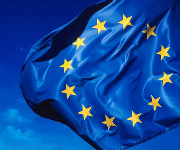Europe made a major commitment under the Kyoto Protocol that U.S. conservatives have been telling us for years it would never achieve. In fact, the Europeans are poised to surpass their targets under the terms of the Protocol. It is no longer plausible for those who don’t want a U.S. cap-and-trade system to point to the European Trading System (ETS) as a failure. Quite the reverse.
A report by the European Environment Agency released today shows that the European Union and all Member States but one [Austria] are on track to meet their Kyoto Protocol commitments to limit and reduce greenhouse gas (GHG) emissions.
Whereas the Protocol requires that the EU-15 reduce average emissions during 2008–2012 to 8% below 1990 levels, the latest projections indicate that the EU-15 will go further, reaching a total reduction of more than 13 % below the base year.…
Looking further ahead, almost three quarters of the EU’s unilateral target to cut emissions to 20 % below 1990 levels by 2020 could be achieved domestically (i.e. without purchase of credits outside the EU).
The report highlights the importance of the EU ETS in helping Member States meet their targets.
That’s a news release, out Thursday, from the European Environment Agency. The full report is here. The report notes:
Five EU‑15 Member States (France, Germany, Greece, Sweden and the United Kingdom) have already achieved average GHG emission levels below their Kyoto target….
The EU ETS is expected to result in important reductions of domestic EU emissions.
The EEA analysis concludes the EU-15 will not need to rely on offsets to meet their Kyoto target and “foresees a variety of factors contributing to the EU-15’s total reduction of more than 13%”:
- Existing policies and measures for the period 2008–2012 could account for 6.9 percentage points of the total reduction.
- If Member States implement additional measures as planned, the total reduction could reach 8.5 percent, although this will largely depend on combined efforts in four main emitting countries (France, Germany, Spain, and the United Kingdom).
- The use of Kyoto’s flexible mechanisms by governments could contribute an additional 2.2 percentage points reduction.
- Absorbing carbon dioxide through enhanced carbon sinks (e.g.improved forest management) will contribute with an additional 1 percentage point reduction.
- Purchase of emission allowances and credits by EU ETS operators is expected to deliver a further 1.4 percentage point reduction.
No doubt some will try to ascribe this success to the global economic collapse, but as E&E News PM (subs. req’d) reported:
The emissions projections should be a sign to the rest of the world, said Andreas Carlgren, the environment minister of Sweden, which holds the bloc’s rotating presidency.
“E.U. emissions reductions far exceed our commitments,” Carlgren said in a statement. “This is taking place without the full impact of the economic crisis yet being evident in the figures. This shows that considered policies and concrete measures are effective in the fight against climate change.”
In fact, the Kyoto budget period covers 2008 to 2012, so it will extend over a period of significant economic growth, and much higher GDP than in the 1990 base period. The United States, by comparison, has also been hit by the same global economic downturn, and our emissions remain significantly above 1990 levels.
The EEA also reports the reductions of the broader EU-27:
The EU‑27 is making good progress towards its 2020 emission reduction target of – 20% and the implementation of planned additional measures is expected to bring domestic emissions down to 14 % below 1990 levels.
The European Trading System, which “covers large carbon-emitting industries, which represent about 40 % of EU greenhouse gas emissions,” is far from perfect. That’s why Climate Progress previously discussed a major August report detailing lessons for U.S. climate bill.
But the bottom is clear: Conservatives and other opponents of the climate bill have been insisting for years the Europeans won’t meet their Kyoto targets and that the ETS was a failure, proof that the U.S. shouldn’t adopt a similar approach. They were wrong on every count. The EU-15 will exceed their Kyoto target, and the ETS is helping them do it. An even better designed trading system in this country, such as is found in both the House and Senate climate bills, can help the U.S. reduce its emissions in a timely and cost-effective manner.




